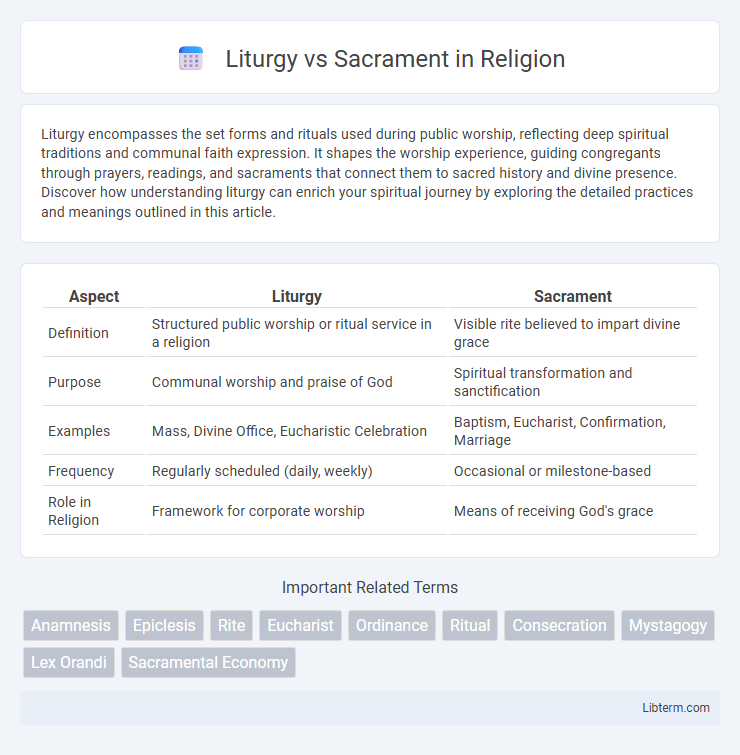Liturgy encompasses the set forms and rituals used during public worship, reflecting deep spiritual traditions and communal faith expression. It shapes the worship experience, guiding congregants through prayers, readings, and sacraments that connect them to sacred history and divine presence. Discover how understanding liturgy can enrich your spiritual journey by exploring the detailed practices and meanings outlined in this article.
Table of Comparison
| Aspect | Liturgy | Sacrament |
|---|---|---|
| Definition | Structured public worship or ritual service in a religion | Visible rite believed to impart divine grace |
| Purpose | Communal worship and praise of God | Spiritual transformation and sanctification |
| Examples | Mass, Divine Office, Eucharistic Celebration | Baptism, Eucharist, Confirmation, Marriage |
| Frequency | Regularly scheduled (daily, weekly) | Occasional or milestone-based |
| Role in Religion | Framework for corporate worship | Means of receiving God's grace |
Introduction to Liturgy and Sacrament
Liturgy encompasses the structured public worship practices of a religious community, serving as a medium for communal prayer and ritual expression rooted in tradition. Sacraments are sacred rites instituted by Christ, functioning as visible signs that confer divine grace and spiritual blessings upon participants. Understanding the distinction between liturgy and sacrament is essential for appreciating how faith communities engage both collective worship and individual sanctification.
Defining Liturgy: Meaning and Scope
Liturgy refers to the structured public worship practices and rituals conducted by a religious community, encompassing prayers, readings, hymns, and sacramental actions that express collective faith. It serves as the official and formalized form of worship that shapes the spiritual life and identity of the congregation, often following a prescribed order or rite. The scope of liturgy extends beyond individual acts, encompassing communal participation, theological symbolism, and the enactment of sacred traditions within various Christian denominations.
Understanding Sacraments: Core Concepts
Sacraments are sacred rites instituted by Christ that convey divine grace through specific signs and rituals, such as Baptism, Eucharist, and Confirmation, forming the foundation of Christian spiritual life. Liturgy encompasses the structured public worship practice, often incorporating these sacraments into communal ceremonies that reinforce faith and doctrinal teachings. Understanding sacraments involves recognizing their role as tangible means of grace within the liturgical context, emphasizing their transformative power and covenantal significance.
Historical Development of Liturgy
The historical development of liturgy traces back to early Christian worship practices shaped by Jewish synagogue traditions and Roman public ceremonies, evolving through centuries to formalize rituals and prayers. Key milestones include the Council of Nicaea (325 AD), which standardized liturgical elements, and the Medieval period that saw the codification of the Mass and Divine Office. The Second Vatican Council (1962-1965) further reformed the liturgy, emphasizing active participation and vernacular languages to enhance congregational engagement.
Origins and Evolution of Sacraments
The origins and evolution of sacraments are deeply rooted in early Christian liturgical practices, where symbolic rites like baptism and Eucharist emerged as tangible signs of divine grace. Over time, the Church formalized these rituals into the seven sacraments, each representing a specific spiritual milestone and means of sanctification. This development reflects a shift from communal worship actions in the liturgy to codified sacred ceremonies that underline the theological and pastoral framework of Christian life.
Key Differences: Liturgy vs Sacrament
Liturgy refers to the structured public worship and rituals conducted by a religious community, embodying the collective expression of faith through prayers, hymns, and ceremonies. Sacraments are specific sacred rites within the liturgy that convey divine grace, such as Baptism or Eucharist, serving as tangible signs of spiritual realities. The key difference lies in liturgy encompassing the overall worship framework, while sacraments constitute integral, grace-bestowing elements within that framework.
Interconnection Between Liturgy and Sacrament
Liturgy and sacrament are deeply interconnected, as liturgy is the public worship practice through which sacraments are celebrated and made present to the faithful. The sacramental rites within the liturgy, such as Baptism, Eucharist, and Confirmation, serve as visible signs that confer sanctifying grace, uniting believers with the divine mystery. This interrelationship underscores the transformative power of liturgical worship in actualizing the spiritual realities of sacraments.
Liturgical Practices Across Christian Traditions
Liturgical practices across Christian traditions vary significantly, reflecting unique theological emphases and ritual expressions within the context of worship. The Liturgy encompasses structured public worship services that include prayers, hymns, Scripture readings, and the Eucharist, serving as a communal encounter with the divine. Sacraments, such as Baptism and Holy Communion, are considered sacred rites instituted by Christ, symbolizing grace and spiritual transformation, and their celebration is embedded within the broader liturgical framework, differing in number and interpretation among denominations like Catholicism, Orthodoxy, and Protestantism.
Theological Perspectives on Liturgy and Sacraments
Theological perspectives distinguish liturgy as the communal worship practice embodying the Church's public prayer, while sacraments are considered outward signs instituted by Christ to confer grace. Liturgical theology emphasizes the participatory nature of the Eucharist, baptism, and other rites as actualizing divine presence and sanctification within the faith community. Sacramental theology explores the efficacy of these rites as means of grace, rooted in biblical foundations and ecclesial tradition, underscoring their role in spiritual transformation and covenantal relationship with God.
Contemporary Relevance and Application
Liturgy and sacraments serve as vital expressions of faith in contemporary Christianity, with liturgy providing structured communal worship that fosters spiritual connection and identity. Sacraments, as sacred rites like baptism and Eucharist, offer tangible encounters with divine grace, reinforcing personal and communal faith experiences. Modern applications emphasize inclusive participation and contextual adaptations, ensuring these practices remain meaningful in diverse and evolving cultural settings.
Liturgy Infographic

 libterm.com
libterm.com